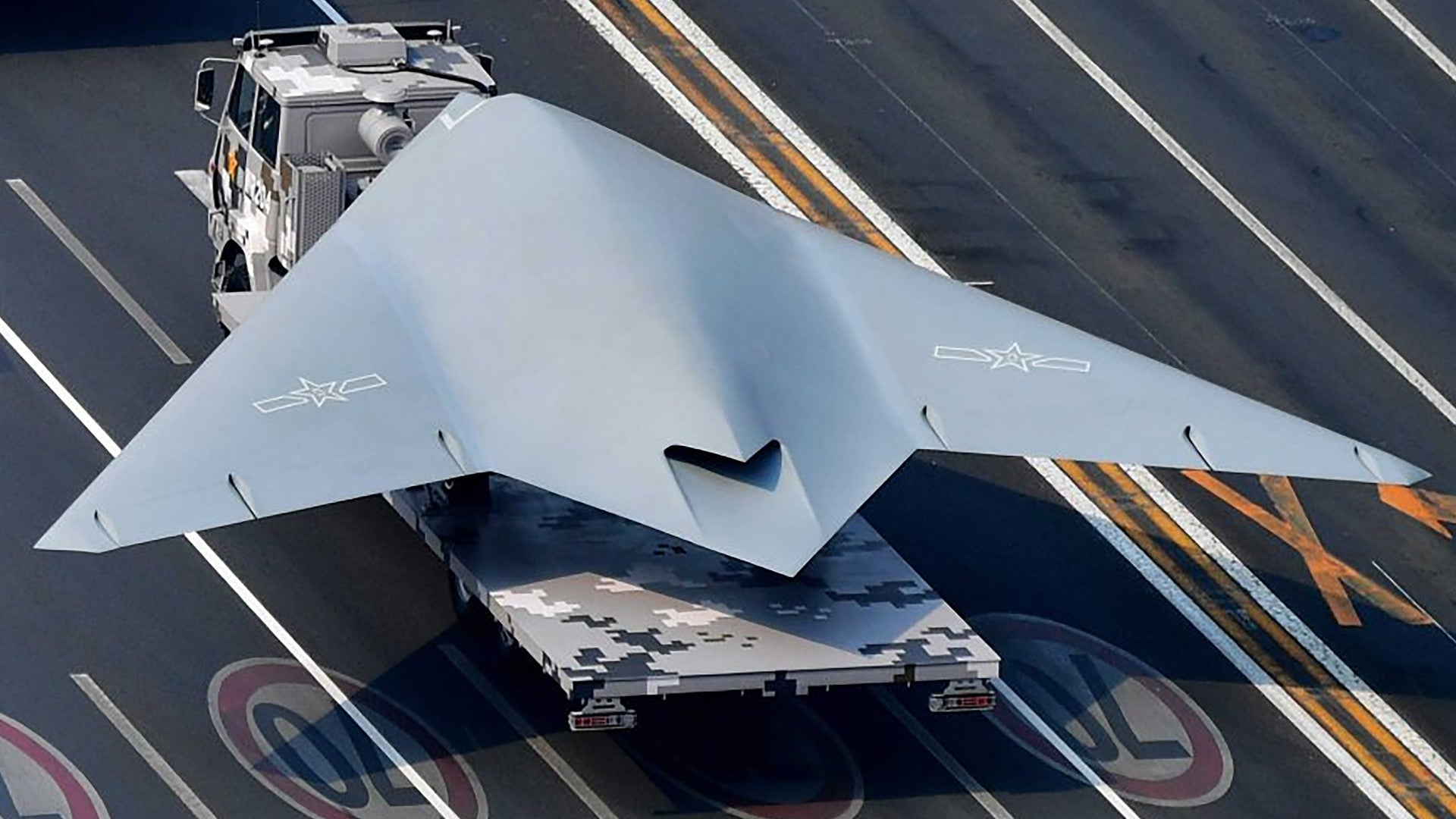China revealed a new iteration of its Sharp Sword stealthy flying wing unmanned combat air vehicle (UCAV) at a parade to mark the 70th anniversary of the founding of the Communist state. The drone, which the Chinese have designated GJ-11, most notably now features a completely redesigned rear aspect with a stealthier exhaust compared to an earlier prototype that could significantly improve the unmanned aircraft’s radar-evading capabilities.
The Chinese paraded a sole example of this improved Sharp Sword through Tiananmen Square in Beijing on Oct. 1, 2019. The event saw the first official public appearances of a number of new and advanced weapon systems, including the DF-41 solid-fuel road-mobile intercontinental ballistic missile (ICBM), the DF-17 hypersonic boost-glide vehicle, a high-speed drone know variously as the DR-8 or WZ-8, a version of the H-6 bomber capable of carrying outsized weapons and other payloads, the HSU-001 large unmanned undersea vehicle (UUV), and a still mysterious missile known as the DF-100, among others.
Pictures of Sharp Sword first emerged on Chinese social media in 2013 and that same year a prototype conducted its first flight. At that time, the design featured an engine arrangement with a completely exposed and decidedly non-stealthy exhaust.
The GJ-11 displayed now has a concealed exhaust and generally more streamlined rear aspect. The intake may also have been revised. It is impossible to tell from the available pictures and video from the parade whether either the intake or exhaust systems feature any sort of ducting that could further conceal the engine, especially its fan face, and further improve the drone’s stealth qualities. It seems safe to assume that incorporating these design features would at least be the eventual goal.


There has also been much speculation since then about what the Sharp Sword’s specific roles and missions might be over the years, with earlier reports indicating that it might be able to carry two 2,000-pound class munitions in internal bays and use a satellite data-link to conduct long-range missions well beyond the Chinese mainland. More recently, there had been unconfirmed, but not unreasonable reports that the People’s Liberation Army Navy (PLAN) might be interested in employing a version of Sharp Sword from its aircraft carriers in an unarmed intelligence, surveillance, and reconnaissance (ISR) capacity, a concept The War Zone
Narrators on China Central Television who were giving a play-by-play of the parade and the weapons and other military hardware on display reportedly said that the GJ-11’s primary mission would be conducting deep penetrating strikes on critical targets. The “GJ” in the designation also stands for “gonji,” or “attack” in English, which would seem to further confirm that this unmanned aircraft is a strike-focused UCAV first and foremost.
Of course, this wouldn’t preclude it from taking on ISR missions, whether it be from bases on land or Chinese aircraft carriers, or from versions of it being built specifically for such a role. Previous reports had suggested that the Sharp Sword prototype was supposed to lead into an improved design that would be operational by 2020.
At the same time, it appears to be very likely, if not probable, that the GJ-11 on parade in Beijing was a mockup of an improved variant that is still in development rather than an actual flyable aircraft. The drone on display lacked a wide variety of features one would expect to see on a flying aircraft, such as visible panel or seam lines, or tape sealing them, any indication of thermal protective treatment to the exhaust area, or air data systems, and the list goes on.
At the 2018 Zhuhai Air Show, the China Aerospace Science and Technology Corporation (CASC) revealed its own UCAV design, the CH-7, which has very broad similarities to the Northrop Grumman X-47B. CASC had a mockup on display that still had a number of features, including panel lines, that one would expect to see on a real aircraft. There are even higher fidelity mockups out there, such as the one for the X-47B itself.

Some observers have also suggested that a number of facets in the trailing edge of the wing on the Sharp Sword in the parade may be part of a non-traditional control arrangement that uses blasts of air rather than conventional control surfaces. It is possible that China might be interested in this sort of technology, in general, but actual examples of work on “morphing wings” and “fluidic thrust vectoring” elsewhere in the world show that these developments are very much in their infancy.
Regardless, official pictures from the parade show the clear outlines of traditional control surfaces. As such, the faceted areas indicate where the control surfaces would come close to joining or are otherwise simply a feature of the design.


When it comes to the GJ-11’s rear aspect, it is worth remembering that engine exhausts are among the most notoriously complicated elements of developing any stealth aircraft, manned or unmanned. The Russians have been facing a similar issue with their S-70 Okhotnik-B, or Hunter-B, UCAV, another flying wing design with clear stealth aspirations. As with the original Sharp Sword prototype, the first flying example of the S-70 also has an exposed engine exhaust. However, in August 2019 at the biennial MAKS airshow outside of Moscow, the manufacturer, Sukhoi, displayed a model of a future iteration with a greatly revised, stealthier rear aspect.
If nothing else, the general layout of the Sharp Sword UCAV in the anniversary parade is the latest indication of how invested the Chinese are in the development of stealthy unmanned aircraft, as well as drones in general. Sharp Sword is just one of the numerous flying wing style unmanned designs that Chinese aviation firms have been producing in recent years. These are developments that The War Zone has been following very closely.

The Chinese have also made significant strides in developing autonomous, networked swarms of small drones, technology that could have some limited applications in larger unmanned designs. This is to say nothing of China’s known work and reported progress on stealthy manned aircraft, including the development of two stealth bombers.
It’s also worth remembering that China’s investment in stealthy UCAVs, in particular, came after the United States publicly turned away from this concept, or moved those efforts entirely into the classified realm. There have been some indications as of late that the U.S. Air Force and the U.S. Navy may be reversing course again, but they might also find themselves now playing catchup.
Whatever the actual state of the GJ-11’s development is or isn’t, China is definitely eager, and publicly so, to push further ahead in developing a real stealth UCAV capability.
Contact the author: joe@thedrive.com
